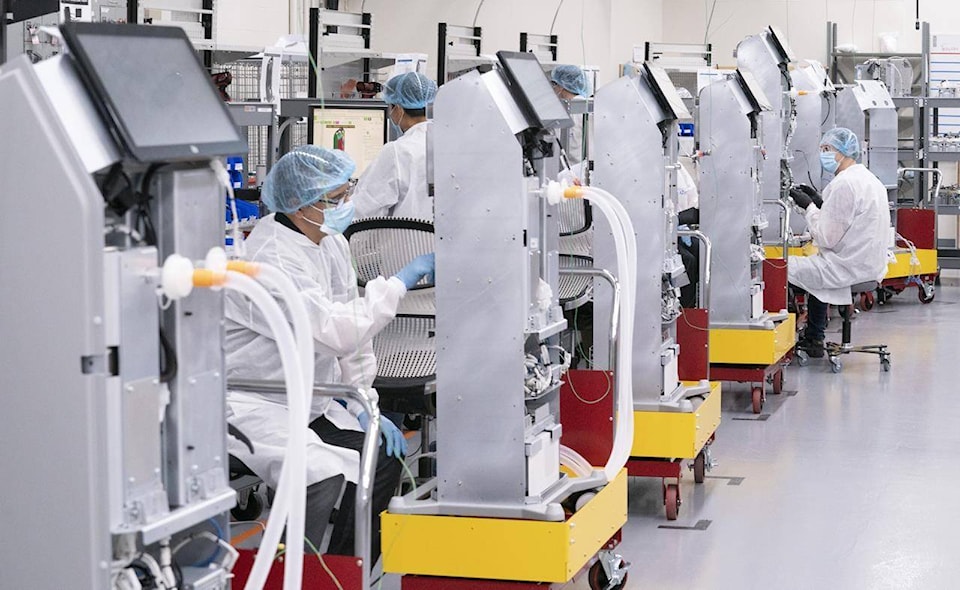CAE Inc. says its recovery from the COVID-19 pandemic will be closely tied to the lifting of travel restrictions and continued demand for private aircraft.
The Montreal-based simulator maker and training company’s outlook is in line with the International Air Transport Association, which expects travel will fall 66 per cent this year and not recover until late 2023 or 2024.
But CAE chief executive Marc Parent is hopeful that Pfizer’s announcement Monday about the efficacy of its new coronavirus vaccine could accelerate the return to normalcy.
“Maybe that gets better because of news we had yesterday. Hopefully it does, that would be great,” he said Tuesday during a conference call about its quarterly results.
While commercial airline traffic has plunged because of the pandemic, there’s been a 50 per cent recovery of daily flight activity from the April lows.
And business aviation, which accounts for about one-third of CAE’s civil aviation business, has been recovering faster than commercial aviation and is within 10 to 15 per cent of pre-pandemic levels, Parent said..
“Anecdotally, our charter operator customers are seeing significant volume in business aircraft from customers who are new to private jet travel and in my experience from nearly 35 years in this industry, once people experience private jet travel, there tends to be a high retention rate.”
CAE shares got a lift after the company beat expectations despite posting lower profits on a dip in revenues.
Its shares gained $1.86 or 6.7 per cent at $29.76 in afternoon trading on the Toronto Stock Exchange.
CAE reported a loss in its fiscal second quarter as it was hit by a one-time $51.1 million restructuring charge related to the COVID-19 pandemic, mainly from impairment charges on non-financial assets and $108.2 million owed from customers.
The restructuring is expected to yield annual cost savings of approximately $50 million, starting in the company’s 2022 financial year.
Its loss attributable to equity holders in the second quarter was $5.2 million or two cents per share compared with a profit of $73.8 million or 28 cents per share a year earlier. It was also better than the $110.6 million loss in the first quarter.
“Short-term visibility remains limited, however, I take confidence in the fact that we’re in a better position now than we were at the start of the fiscal year. We continue to expect a stronger second half,” he told analysts.
Parent added that he sees lots of opportunities to get new business for its defence operations and doesn’t foresee any challenges from a change in U.S. administrations with the election of Democrat Joe Biden as president.
“I think we have lots of opportunities to grow within the defence budgets that are out there today and foreseen to be out there under any reasonable scenario,” he said, adding that simulator training saves money.
“I feel good about our prospects for growth in the next few years.”
Revenue totalled $704.7 million for quarter ended Sept. 30, down from $896.8 million in its second quarter last year.
CAE says its net income before specific items for the quarter amounted to $34.2 million or 13 cents per share for the quarter, down from $74.7 million or 28 cents per share in the same quarter last year.
The results were “well ahead of expectations,” said Steve Arthur of RBC Dominion Services Inc.
Analysts on average expected CAE would report a two cents per share adjusted loss on $634.6 million of revenues, according to financial data firm Refinitiv.
COVID-19 continues to have a profound impact on CAE’s customers but the company saw its training utilization recover to 49 per cent from 33 per cent in the first quarter. That’s up from expectations of 40 per cent utilization, still below normal use of more than 70 per cent.
It also demonstrated strength in business jet training contracts and the delivery of 10 full-flight simulators and three new orders.
“Bigger picture, we continue to like CAE’s long-term positioning and potential,” Arthur wrote in a report.
“Clearly COVID-related headwinds will persist in the near- and midterm (though vaccine news is certainly encouraging and supportive to end-markets), but we expect CAE to emerge with an even wider competitive lead, lower cost base, and technology platforms to drive future growth.”
He added that CAE’s aggressive cost-cutting at the start of the pandemic is paying off with its civil aviation margin recovering faster than anticipated, paving the way for the EPS outperformance, positive free cash flow and a reduced leverage ratio.
This report by The Canadian Press was first published Nov. 10, 2020.
Companies in this story: (TSX:CAE)
Ross Marowits, The Canadian Press
